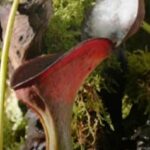As an Amazon Associate, this site earns commissions from qualifying purchases. For more details, click here.
Since pitcher plants are carnivorous and eat various types of bugs, can they feed on mosquitoes too? And if the answer is yes, can nepenthes or sarracenia be used as a natural mosquito repellent? This article will explain the facts and dispel some myths about the topic as well.
Pitcher plants eat mosquitoes for their nutritional benefits. The nectar the plant produces attracts insects which are drawn to sugar such as house flies, ants and so on. Pitcher plants only eat 1-4 insects a month so it is not a very effective insect repellent.
How Many Mosquitoes Can Pitcher Plants Eat?
Pitcher plants can be fed 1 to 4 times a month. If your plant has already eaten three bugs, you can only give it one mosquito this month. You can put more insects in its pitchers but there is no guarantee the plant will eat them.
Can you overfeed pitcher plants? It is possible but unlikely. They only digest the amount of insects required to fulfill their nutritional requirements. Once the plant has had its fill, any mosquito (or any bug for that matter) left in its pitcher will just decay. This can cause an unpleasant smell so you should remove the dead bug.
If your nepenthes or sarracenia is outdoors you have little control over how many mosquitoes it eats. That is nothing to worry about as the plant will not eat more than it can handle. So while those pitchers are large enough to hold several bugs, in reality nepenthes and sarracenia only consumes a few of them.
But what if your plant is indoors and you drop several mosquitoes in the pitcher? Will the plant digest them?
Nutrition
Pitcher plants eat bugs for nutrients. Once their needs are met it will not eat anymore. Any mosquito you drop in the pitcher will just stay there until it rots or the plant uses up its nutrients and has to eat again.
If your pitcher plant has other sources of nutrition it will eat even fewer insects. you can for instance, feed nepenthes with Cool Mysis Tropical Fish Flakes. So even if the plant fails to catch any bugs, its nutritional needs will be met.
The liquids in the pitcher traps any bugs that fall in. But unless the plant releases digestive enzymes, the insect will just remain there. Do not put pitcher plants in standing water just to attract mosquitoes as that could be a breeding ground for diseases.
If you want to feed mosquitoes to your pitcher plant, keep it to no more than 1 to 4 a month. And you should not feed the plant food for human consumption. In terms of nutrition, mosquitoes are similar to other prey pitcher plants feed on. You can mix and match bugs as long as it is no more than 4 times a month.
How Do Pitcher Plants Attract Mosquitoes?
There is a misconception that pitcher plants do not attract mosquitoes because their nectar is sugary sweet, whereas mosquitoes are drawn to blood. In fact, mosquitoes need sugar more than blood to survive.
Pitcher plants only grow in poor soil which lacks the nitrogen they need. By producing nectar, the plant is able to attract insects and lure them into its trap.
The pitcher is covered with the sweet nectar to entice unsuspecting prey. When a mosquito flies down on the pitcher rim, it falls into the trap. The rim is coated with this nectar and is very slippery.
When the bug falls into the pitcher, the liquids inside hold it down and prevent it from crawling – or in the case of mosquitoes – flying off.
With proper watering pitcher plants will produce the fluids needed to trap mosquitoes and other bugs. Once trapped, the plant releases its digestive liquids to eat the bug. This might take several days depending on the size of the prey.
Strictly speaking, “eating” is incorrect because what the plant does is break down the insect into goo. The pant absorbs the goo and its own digestive fluids. Then the plant converts these into nitrogen and other elements.
That is a basic explanation of how pitcher plants eat mosquitoes, but this is how nepenthes and sarracenia catch all bugs.
For this to work, pitcher plants must have enough energy to produce pitchers and nectar. For this they need plenty of sunlight, water, the right soil and food.
Only healthy pitcher plants can produce traps and the liquids inside them. Whether your pitcher plants are indoors or outdoors, they can still catch bugs with proper nutrition in the right environment.
Why Do Pitcher Plants Eat Mosquitoes?
Carnivorous plants consume mosquitos and other bugs to get nutrients. Pitcher plants do not necessarily need to eat bugs to live, but their nutrients offer a lot of benefits.
Pitcher plants do not really eat bugs as food. When a mosquito falls into the pitcher, its tissues are broken down and goes back into the plant. This process is not the same as eating as plants do not have digestive systems like animals.
Second, pitcher plants produce their own food through photosynthesis. With sufficient light these plants produce glucose, which can be considered plant food. These are not food like what animals eat, but they provide energy for plants to perform their daily activities so the comparison is valid.
So if pitcher plants generate their own food, what do they need mosquitoes and other bugs for? These insects contain nutrients that these plants need for extra strength.
While glucose provides pitcher plants with their day to day energy requirements, nutrients from insects give them additional resources. Properly fed pitcher plants will produce plenty of pitchers with fluids inside them.
It is all right for your carnivorous plants not to have any mosquitoes in its diet. But it must have some kind of food fed to it once a month minimum. Of course if you have an outdoor pitcher plant it will have access to all the nutrients it needs.
Live vs.Dead Mosquitos
These carnivorous plants can survive without eating bugs, but they will not be as healthy. It does not matter if the bug is dead or alive, the plant does not make any distinctions.
To feed a dead mosquito, just drop it into the pitcher. Leave it there and the plant will digest it. How long it takes depends on the variant and how much the plant has fed. Catching and killing mosquitoes is not easy so this is not practical for a lot of people.
If you really want mosquitoes to be part of its diet, leave your nepenthes outdoors. It should draw all kinds of over time. Keep checking the pitchers and you will probably see a mosquito or two there at some point.
if you want keep your pitcher plants indoors, fed it fish pellets or freeze dried worms. A good one wold be San Francisco Bay bloodworms because it is healthy for carnivorous plants.
Are Pitcher Plants Effective Mosquito Repellents?
No, pitcher plants are not good mosquito repellents. While their pitcher can trap small insects, the plant only eats a small number of bugs, limiting its usefulness as a repellent.
Whether it is a Venus flytrap, sundew or pitcher plant, this question always gets asked. Are these plants going to be effective as natural bug controllers? In particular how effective are they in keeping mosquitoes away? Or will they cause these bugs to pester your yard even more?
Pitcher plants do not lead to an increase in mosquito presence. But you should not use the plants to keep these insects away. If there are lots of mosquitoes in your property, find out the source. That is a more effective method than relying on pitcher plants to trap each one.
Even if you buy several pitcher plants, it is not practical to depend on them to get rid of your mosquito problem. Now if you just want to get rid of the occasional bug that gets in your house or garden, a nepenthes or two will do. But if you have a serious mosquito problem, find out what is drawing them to your property.
Conclusion
Pitcher plants may catch mosquitoes on occasion, but it is not really a big part of their diet. If yours does eat them regularly that is great. But please do not rely on the plant to be a repellent because it will only eat mosquitoes – or any bug – when it needs to.

My fascination with carnivorous plants began many, many years ago with Venus Fly Traps. Now I am more than happy to impart what I know with other enthusiasts and those who are curious about meat eating plants.



